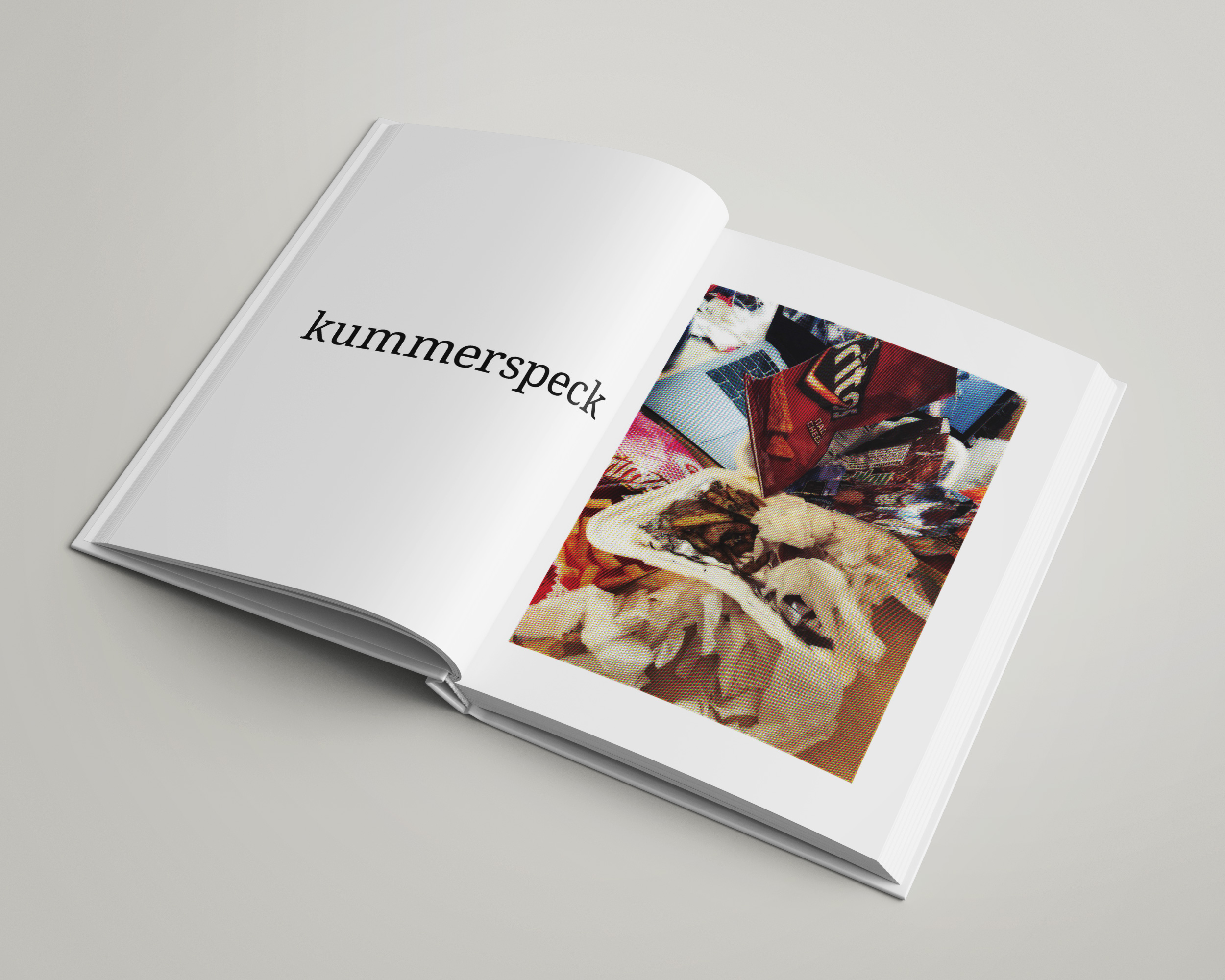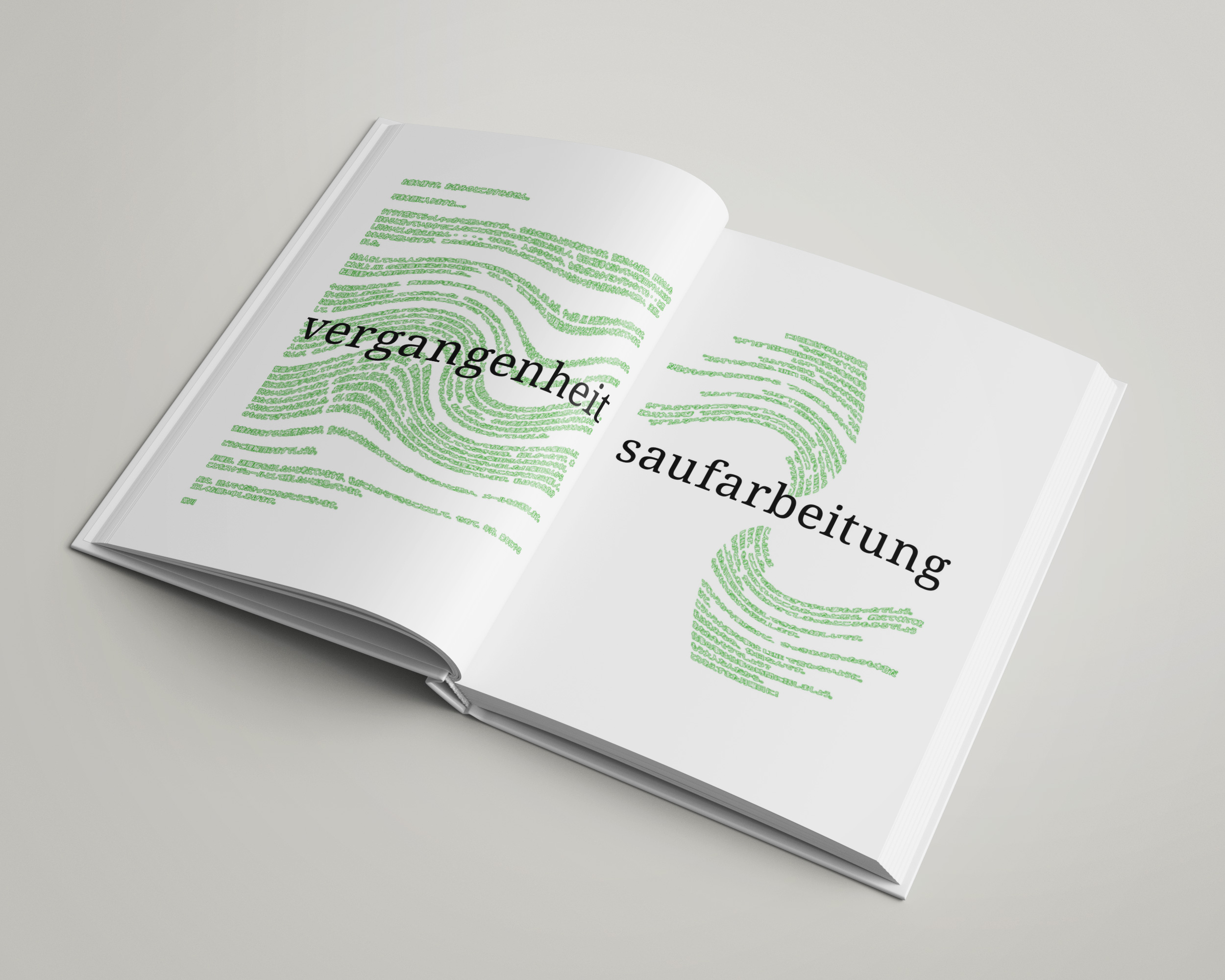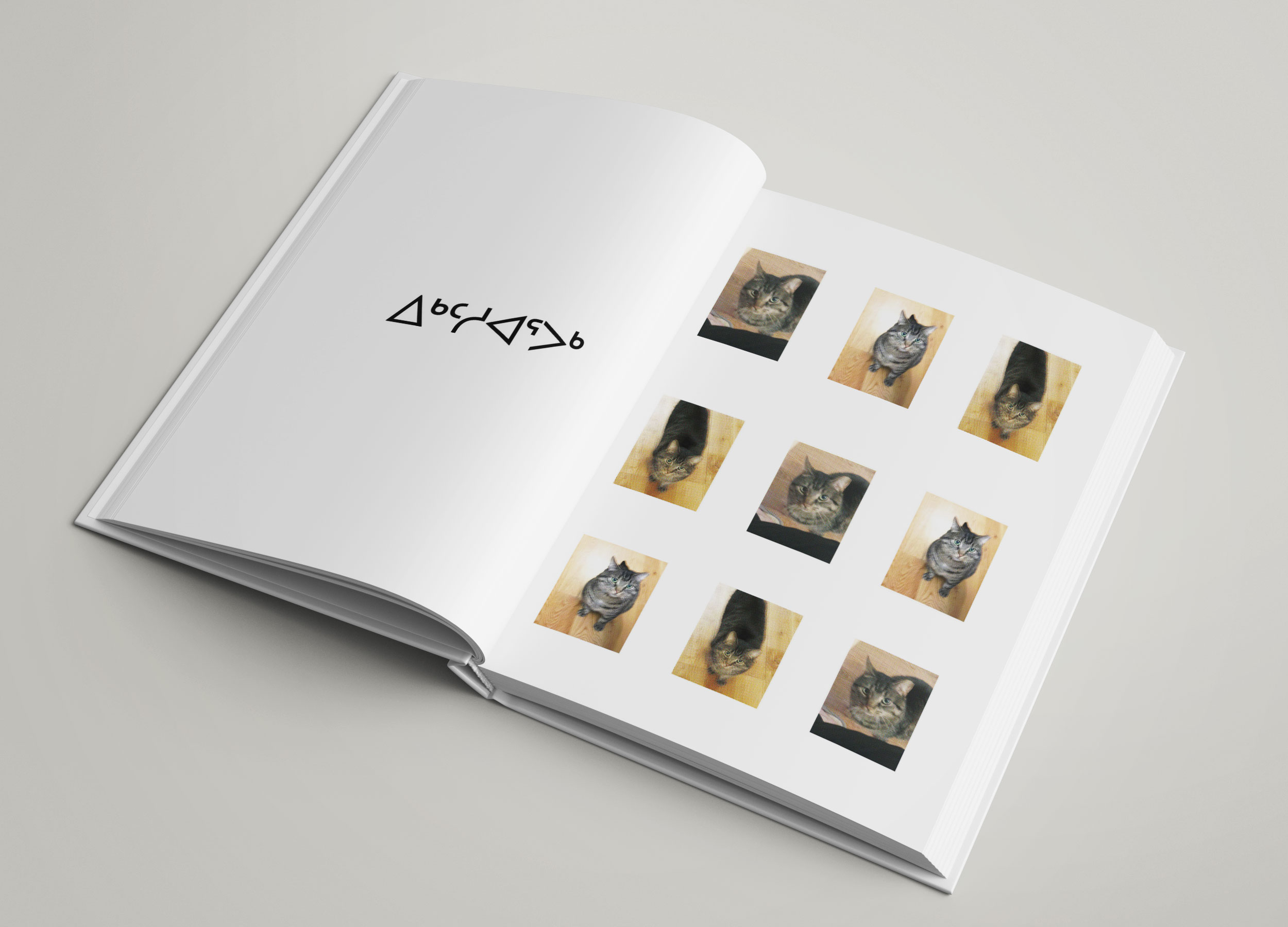EXTRANSLATION
Graduate thesis (2020),
MFA Communications Design,
Pratt Institute
About this thesis ⟶
Glossary of Terms ⟶
Next Step ⟶
Bibliography ⟶
︎Learn more ⟶
RESEARCH QUESTION
How can shifts in context and form enlarge the scope of communication?
CAPSTONE PROJECT
![]()
This riddle book contains visual translations to “non-translatable words and phrases.”
No literal translations or explanations are included, aiming the audience to associate with “non-translatable words and phrases,” expecting the audience to go through the confusing process of translation by guessing and associating the visual and the words written.
The process of going through the book was confusing to the participants. They try to associate their past experiences and knowledge to associate the visual interpretation and the unfamiliar characters and letters written on each page. The association between the unknown letters and the visual rely on their knowledge and linguistic background. This also includes the cultural and social environment they had been, where, and how their way of thinking had shaped.
Mandarin speakers occasionally get confused on Cantonese words, since they use the same characters but use them differently. While they find Cantonese confusing despite the geological closeness, they can make out meanings more in some of the Japanese words; occasionally, both Japanese and Mandarin share the same concept, same characters, the same form of a term.
︎View spreads at issue.com
︎Download spreads (PDF)
︎Share your translation with me!
How can shifts in context and form enlarge the scope of communication?
CAPSTONE PROJECT

This riddle book contains visual translations to “non-translatable words and phrases.”
No literal translations or explanations are included, aiming the audience to associate with “non-translatable words and phrases,” expecting the audience to go through the confusing process of translation by guessing and associating the visual and the words written.
The process of going through the book was confusing to the participants. They try to associate their past experiences and knowledge to associate the visual interpretation and the unfamiliar characters and letters written on each page. The association between the unknown letters and the visual rely on their knowledge and linguistic background. This also includes the cultural and social environment they had been, where, and how their way of thinking had shaped.
Mandarin speakers occasionally get confused on Cantonese words, since they use the same characters but use them differently. While they find Cantonese confusing despite the geological closeness, they can make out meanings more in some of the Japanese words; occasionally, both Japanese and Mandarin share the same concept, same characters, the same form of a term.
︎View spreads at issue.com
︎Download spreads (PDF)
︎Share your translation with me!
EXPERIMENTS AND PROJECTS






STUDIO EXPERIMENT:
Cross-linguistic Conversation
This video is a summary of three experimental conversations. Each of them was conducted between two people, each speaking a different language. Their conversations were performed with no prompts and ended in two minutes.
Cross-linguistic Conversation
This video is a summary of three experimental conversations. Each of them was conducted between two people, each speaking a different language. Their conversations were performed with no prompts and ended in two minutes.
The following are three videos in detail:
Conversation 1 was rather easy because of a similar cultural background and the sounds in the linguistic structure; they are in the same language family, and geographically close. Participants tried to communicate by translating those familiar sounds and cultural backgrounds to build conversations, though this sometimes was the factor that led to misunderstandings. For example, because the Japanese “ハン(ha-n)” sound is associated with “飯 (rice, meal),” when Mandarin speaker was talking about “hamburger,” the participant was confused with “ham” sound, because of the pronunciation and the context of the conversation.
- Japanese (spoken by a Japanese) and Mandarin (spoken by a Taiwanese)
- Japanese (spoken by a Japanese) and Tamil (in Chennai dialect, spoken by a Tamil)
- Japanese (spoken by a Japanese) and Hindi (spoken by a Hindu)
Conversation 1 was rather easy because of a similar cultural background and the sounds in the linguistic structure; they are in the same language family, and geographically close. Participants tried to communicate by translating those familiar sounds and cultural backgrounds to build conversations, though this sometimes was the factor that led to misunderstandings. For example, because the Japanese “ハン(ha-n)” sound is associated with “飯 (rice, meal),” when Mandarin speaker was talking about “hamburger,” the participant was confused with “ham” sound, because of the pronunciation and the context of the conversation.
In conversation 2, the notable thing was that the sound of “O-pa” and “O-ma” in Tamil; Those “pa” and “ma” sounds could be found in many other languages representing “Dad” and “Mom.” Although those sounds are not familiar in Japanese, the Japanese participant could assume that the Tamil participant was trying to explain something about her parents.
In conversation 3, the Japanese and Hindu participants did not share a common cultural background, and also were not very familiar with each other and not so familiar. However, in this conversation, the two participants used facial expressions and body language to communicate, which was mostly successful.
STUDIO EXPERIMENT:
Cross-Linguistic Audio
This piece aim to realize the different density and tempo in each linguistic translation of the famous Hamlet’s soliloquy. This piece contains Hamlet's soliloquy in eight different languages, showing the different length, tempo, and the density of each context over the same concept. This leads to interpretation of each words and phrases being different in the organization of phrases and structure, directness and indirectness in the each expressions.
Cross-Linguistic Audio
This piece aim to realize the different density and tempo in each linguistic translation of the famous Hamlet’s soliloquy. This piece contains Hamlet's soliloquy in eight different languages, showing the different length, tempo, and the density of each context over the same concept. This leads to interpretation of each words and phrases being different in the organization of phrases and structure, directness and indirectness in the each expressions.
STUDIO EXPERIMENT:
100 Fragmentation
100 Fragmentation
The machine translation resulted in almost nothing but nonsense or unnatural sentences, sometimes changed the whole original concept, and by generating grammatical errors, it showed how the original concept could be broken down and fragmented grammatically. On the other hand, human translation included factors that are more than “direct translation,” such as interpretations, explanations, and considerations in transitions of different grammar structures. For example, the Japanese language contains various kinds of onomatopoeia and symbolic sounds, while English does not. “パタパタ (pa ta - pa ta)” in Japanese means something light is fluttering, or expresses the sound or the feeling of light, or quick and soft, footsteps; human translator used “patter” to translate this sound, but the machine translation resulted using “flatter.”
“トテトテ (toh te - toh te )” in Japanese also means the the sound or the feeling of light, or quick and soft, footsteps, but more solid and hard compared to “パタパタ (pa ta - pa ta).” “トテトテ (toh te - toh te )” might be used to describe a barefooted toddler running clumsily on the wooden floor, while “パタパタ (pa ta - pa ta)” might be the description of footsteps of a girl with slippers walking around. To translate “トテトテ (toh te - toh te )” in English, there are not many options. In this project, the human translator chose to use “thump, thump, thump,” knowing this expression does not give the same sense as the original, and the machine translator could not do any translation; the result it gave was “totetotetote.”
“トテトテ (toh te - toh te )” in Japanese also means the the sound or the feeling of light, or quick and soft, footsteps, but more solid and hard compared to “パタパタ (pa ta - pa ta).” “トテトテ (toh te - toh te )” might be used to describe a barefooted toddler running clumsily on the wooden floor, while “パタパタ (pa ta - pa ta)” might be the description of footsteps of a girl with slippers walking around. To translate “トテトテ (toh te - toh te )” in English, there are not many options. In this project, the human translator chose to use “thump, thump, thump,” knowing this expression does not give the same sense as the original, and the machine translator could not do any translation; the result it gave was “totetotetote.”
︎View full spreads (PDF)
STUDIO EXPERIMENT:
Visualizing Implication
By realizing the framework, this animation intends to reveal the linear timeline of history and cultivates reconstruction through a translation procedure. The animation shows how ancient poetry written in China was translated into Japanese, and how the general concept is still preserved in a modern context. It also indicates how specific contexts go through the decoding process visually and culturally, and organized within a different context in order to be understood and reproduced into another form, thus reflecting different social and environmental situations.
Visualizing Implication
By realizing the framework, this animation intends to reveal the linear timeline of history and cultivates reconstruction through a translation procedure. The animation shows how ancient poetry written in China was translated into Japanese, and how the general concept is still preserved in a modern context. It also indicates how specific contexts go through the decoding process visually and culturally, and organized within a different context in order to be understood and reproduced into another form, thus reflecting different social and environmental situations.

STUDIO EXPERIMENT:
“Para-Calligraphy”
“Para-Calligraphy”
Responses to this project shows how styles and forms impact the concepts and messages it contains, as well as each participant’s knowledge and cultural background. The background of participants are monolingual Americans, a multilingual Singaporean who is familiar with Mandarin, Taiwanese and Chinese fluent in Mandarin, Japanese who are fluent in calligraphy and those who are not. People who are fluent in calligraphy get to the idea of “writing alphabets in calligraphic style” rather easily, while people who only have an introductory level of calligraphy with eastern language background clouded their thinking; in previous case, participants are free to change the angles and flip the piece.
Participants in the latter case are trapped in the stereotype of “Japanese calligraphy.” There was one peer who has been working on calligraphy practice for years, and she considered every other calligraphy style not only in Japanese or Mandarin, but Korean or Mongolian, and got to the point of writing alphabet in brush and traditional ink. She said that in the modern calligraphy text, although writing styles are different, there are examples to write western alphabets in Japanese calligraphy.
Participants in the latter case are trapped in the stereotype of “Japanese calligraphy.” There was one peer who has been working on calligraphy practice for years, and she considered every other calligraphy style not only in Japanese or Mandarin, but Korean or Mongolian, and got to the point of writing alphabet in brush and traditional ink. She said that in the modern calligraphy text, although writing styles are different, there are examples to write western alphabets in Japanese calligraphy.
For the future outlook of this thesis: Next Step ⟶
